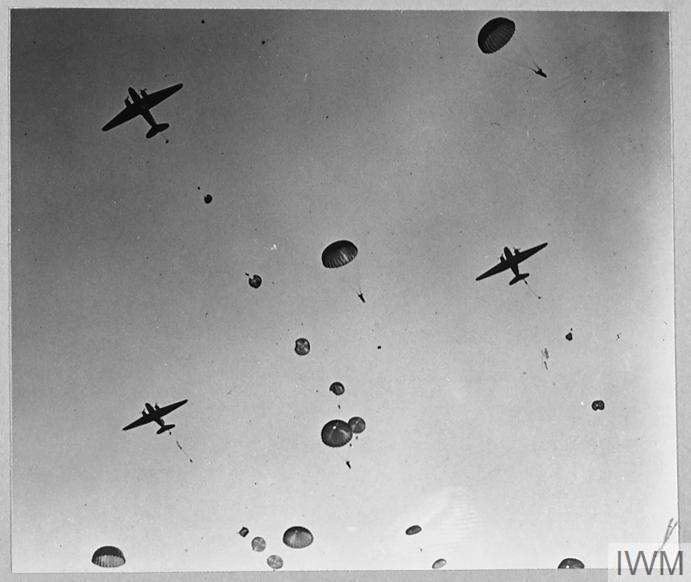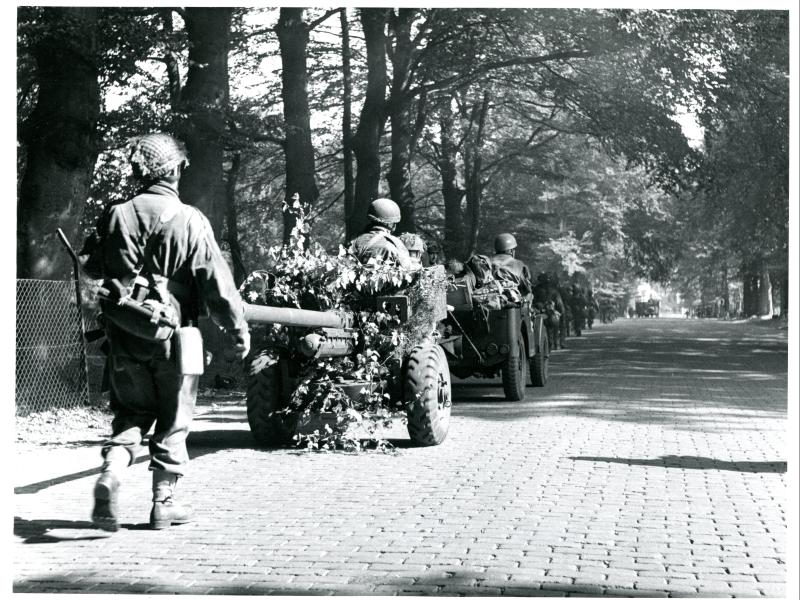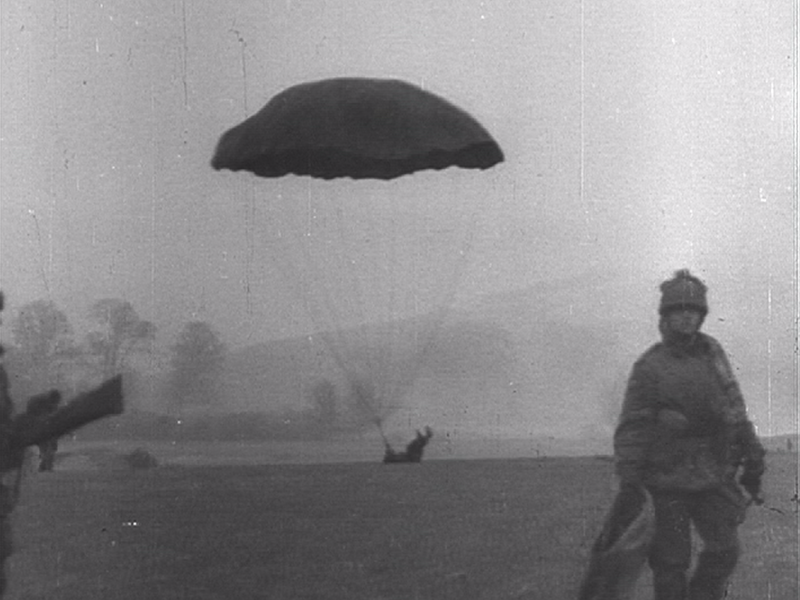Exercise WILLIAM, 15/16 March 1944

Note:
The War Office base map used in this document is Sheet 55 (Grantham) of the England and Wales One-Inch Popular Series, GSGS 3907 - 1933-43, and is reproduced with the permission of the National Library of Scotland. It can be accessed online here: Map Sheet 55 Grantham of the wartime military Ordnance Survey series
Aim and Timing of the Exercise
Exercise WILLIAM was devised by the 1st Parachute Brigade of the British 1st Airborne Division to practise the Brigade in:
- Occupation by night and subsequent development of a Brigade defence locality.
- The planning and execution of an immediate counterattack by day within a Battalion locality, and a deliberate counterattack by night within the Brigade locality.
According to Instructions issued by HQ 1st Parachute Brigade in early March 1944, Exercise WILLIAM was due to begin at 1600 hrs on 15 March 1944 and end at approximately 0100 hrs on 17 March 1944; provision was made to postpone the exercise for 24 hours if the weather was unsuitable.
Exercise Scenario
The east bank of the River Trent represented the coast of France. The 1st British Corps would land between West Bridgeford and Gainsborough on 14 March 1944 and push ‘inland’ (eastwards) to seize Boston and Spalding. Airborne landings in support of the advance would take place on 16 March 1944, by which time the axis of 1st Corps’ advance would be eastwards along the line of the Grantham-Donington road (see map below).
To help secure the line of advance, the 1st Parachute Brigade would parachute behind enemy lines to seize and hold the area between the villages of Dembleby and Newton (north and south of the axis of advance) until relieved by 1st Corps. The 1st Parachute Brigade had three parachute battalions, each comprising around 550 men. The 1st Parachute Battalion would deploy in and around the village of Newton and the 3rd Parachute Battalion in and around Dembleby; the 2nd Parachute Battalion would take up positions midway between the two villages and to the west of the 1st and 3rd Battalions (see map below). The Brigade’s tasks were firstly to prevent the enemy from moving reserves westwards, and secondly to cut off any enemy withdrawal eastwards along the axis of advance.
The specific task of the 2nd Battalion was to prepare to counter-attack the positions held by the 1st and 3rd Parachute Battalions if the enemy was overrunning them, while leaving sufficient troops in its original locality to cover any roadblocks and delay any enemy approaching from the west.
All Battalions were to prepare roadblocks on the main approaches to the Brigade locality and were to establish battle patrols on side roads leading into the Brigade’s positions. The task of the patrols was to delay enemy contact with the Brigade’s main positions and to force the enemy to deploy.
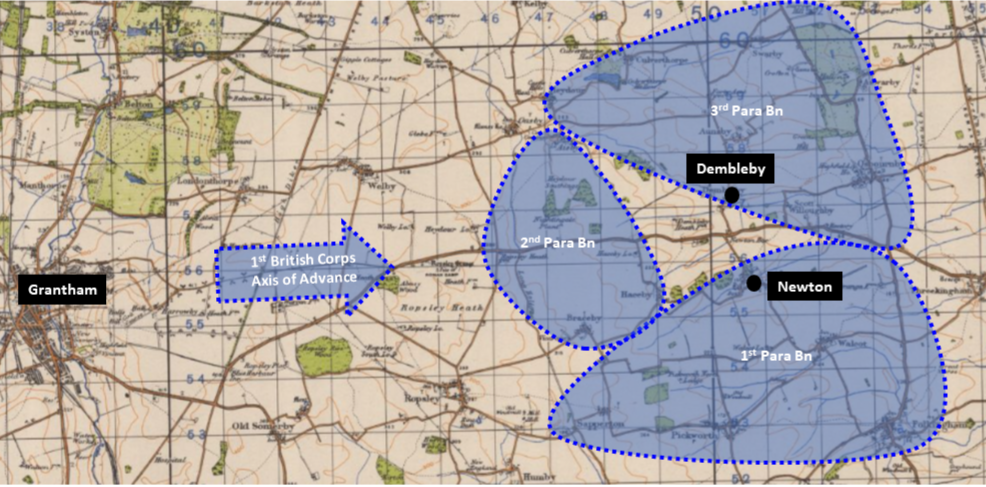
Allied axis of advance and 2nd Parachute Battalion's Areas of Responsibility.
Participants
The initial Brigade plan called for some participants in the exercise to be delivered by parachute and some by vehicle.
By Parachute:
- HQ 1st Parachute Brigade
- Brigade Defence Platoon
- Brigade Signals Section
- 1st Parachute Battalion
- 2nd Parachute Battalion
- One Parachute Platoon of the Royal Army Service Corps
- Detachment of 21st Independent Parachute Company (Pathfinders)
By Vehicle:
- 3rd Parachute Battalion
- 1st Airlanding Anti-Tank Battery, Royal Artillery
Representatives of 1st Parachute Squadron, Royal Engineers, would also take part. Royal Artillery Forward Observation parties would be supplied by 2nd Army and 1st Airlanding Light Regiment, Royal Artillery.
It was hoped that 80 aircraft would be available to transport the paratroops: 76 from the US 61st and 313th Troop Carrier Groups at Barkston Heath and Folkingham respectively, and four from No 38 Group, RAF.
Units not dropping would be taken by motor transport to a drop-off point, from where they would march to the dropzone (DZ) at Ropsley Heath, east of Grantham. This would ensure that the DZ was kept clear of vehicles when the planned drops took place.
Each man was to be issued with one 24-hour ration pack. Ammunition issues were 10 rounds of blank ammunition to each member of the ‘friendly’ forces, and 25 rounds to the ‘enemy’. This is a small amount of training ammunition and may reflect the pressure on training ammunition caused by large numbers of Allied forces in the UK training intensively for a future invasion of Europe. Although the participants in Exercise WILLIAM did not know it at the time, the Allied invasion of Normandy would take place on 6 June 1944 - less than three months later (however, 1st Airborne Division would not be deployed to Normandy but would be held in reserve by the British 21st Army Group for use if required).
All troops were to dig in as they would on operations, but emphasis was placed on minimizing damage to land and property, so trenches were to be dug into hedgerows whenever possible and filled in before the end of the exercise. In addition, vehicles were instructed not to move across cultivated fields.
The Enemy
Members of the 1st Airlanding Reconnaissance Squadron would simulate enemy forces. Their personnel would wear their maroon berets to distinguish them from friendly forces, who would wear steel helmets, and their vehicles would fly a red flag as high as possible above the vehicle.
THE REALITY
Before Exercise WILLIAM began, an amendment to the exercise instructions was issued. Among several changes to the plan, the document stated that no aircraft or gliders would be available for the exercise. As a result, the Pathfinders of the 21st Independent Parachute Company would not take part in the exercise, and all participants and supplies would be taken to drop-off points by vehicles.
There were distractions before and during the exercise. On 14 March 1944, the 1st and 4th Parachute Brigades were inspected at Belton Park, Grantham, by General Bernard Montgomery, commander of the British 21st Army Group. Although General Montgomery may have thought that his visit was appreciated, the War Diary of the 1st Parachute Battalion makes the following observation:
Bde inspected by Monty at BELTON PARK. Usual confidential chat, surrounded, however, by a group of rather cynical soldiery.2
Exercise WILLIAM began late on 15 March, but its flow was interrupted around midday on 16 March when a temporary ‘ceasefire’ came into force during an inspection of 1st Airborne Division units by HM King George VI.
Regarding these distractions, historian Dr William Buckingham, author of Arnhem 1944, comments:
These inspections may have been brief, but, the British army being the British army, it would be extremely surprising if they were not preceded by an inordinate amount of preparation, even allowing for the operational orientation of Airborne Forces.3
The entries in unit War Diaries about Exercise WILLIAM range from detailed reporting to very brief mentions of the exercise. Of the three Parachute Battalions, the most detailed entries are those made by the 2nd Battalion.
1st Parachute Battalion4
The 1st Parachute Battalion’s War Diary contains little information about the Battalion’s participation in Exercise WILLIAM. It states that the Battalion left for the exercise at 2315 hrs on 15 March 1944 and that the Battalion’s positions were visited by HM King George VI at 1230 hrs on 16 March 1944, as part of his visit to the 1st Parachute Brigade.
An entry in the War Diary of the 2nd Battalion made at 1630 hrs on 16 March states that the enemy overran the positions of the 1st Battalion around the village of Newton during that afternoon. The 2nd Battalion counterattacked these positions at 1930 hrs, recapturing them by 2015 hrs.
The 1st Battalion’s War Diary notes that the Battalion learned several lessons from the exercise, including:
- Wireless Sets No. 38 (manpack radios with a maximum range of 0.75 miles) were essential for the Intelligence Section to control Observation Posts.
- Observation Posts should be established before first light and should also be the first consideration when occupying an objective.
- Situation Reports (SITREPs) should be passed from Companies to the Battalion HQ every hour.
- SITREPs should be passed from Battalion HQ to Companies every two hours.
- A unified system of marking maps should be used throughout the Battalion.
[Note: The British Army’s 1943 Field Service Pocket Book, Part 1- Pamphlet No 6-A, Conventional Military Symbols laid down a unified system of map marking for the whole of the British Army and should have been used during the exercise. The War Diary does not state why this system was not used during Ex WILLIAM. One possibility is a mixing of British and American map-marking conventions during the exercise. Units of the British 1st Airborne Division had worked alongside US units in North Africa and Sicily. The British and US Armies had independent map-marking conventions and there was scope for confusion between them. For example, according to the British convention, own and Allied units were to be marked in red on maps, with enemy units marked in blue. The US Army convention was exactly the opposite: own and Allied troops were marked in blue and enemy units in red. It is possible that some confusion had resulted from a mixture of British and US conventions being used during the exercise, but it is not possible to confirm this.]
- All patrol commanders must report to Battalion HQ immediately on return.
- Patrol reports were to be taken by the Intelligence Officer.
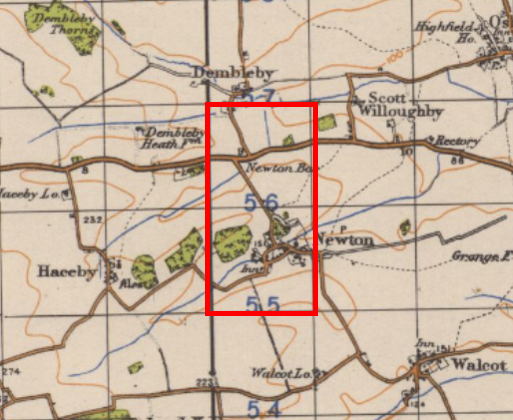
The 1st Parachute Battalion positions attacked by the ‘enemy’ were located within the area outlined in red; the 2nd Para Bn later recaptured these positions.
2nd Parachute Battalion5
In the absence of aircraft for dropping troops and equipment, each battalion made its own transport arrangements for moving to an assigned debussing point. For the 2nd Parachute Battalion, these were published in its Admin Instruction No 1 on 15 March 1944. This stated that six trucks per Company would arrive in the Company locations at around 1630 hrs on 15 March. Companies were then to move off independently to the Battalion debussing point at Ropsley Heath, east of Grantham, following a designated route from Great Ponton.
From the debussing point, the Companies were to make their own way to their allocated Rendezvous Points (RVs) by 0200 hrs on 16 March.
- 5
Information for this section taken from the 2nd Parachute Battalion War Diary and Appendices for March 1944, held by the National Archives under reference WO 171/1237.
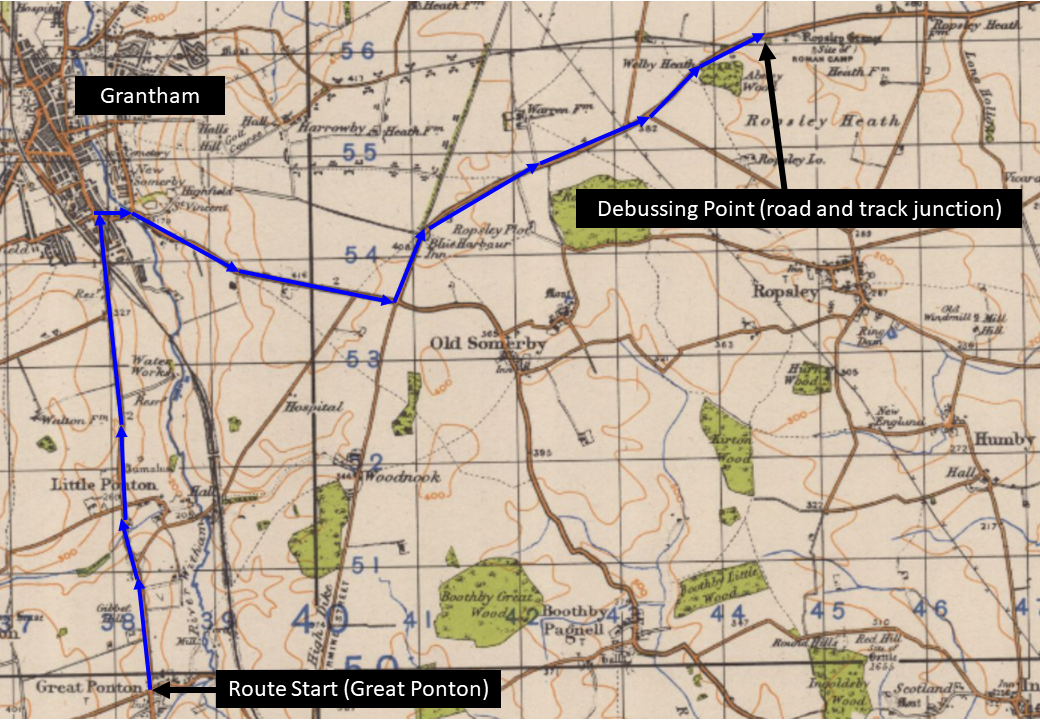
2nd Parachute Battalion motor transport route from Great Ponton to the debussing point at Ropsley Heath.
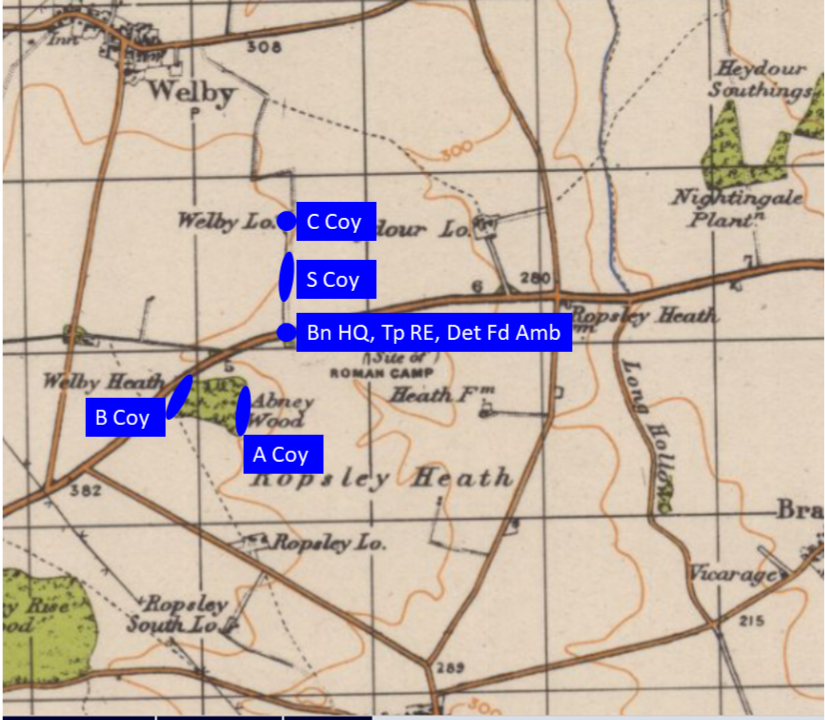
2nd Parachute Battalion Rendezvous Points at start of exercise. Abbreviations:
Bn HQ = Battalion Headquarters
Tp RE = Troop of Royal Engineers
Det Fd Amb = Field Ambulance Detachment
A,B,C,S Coy = A,B,C,S Company
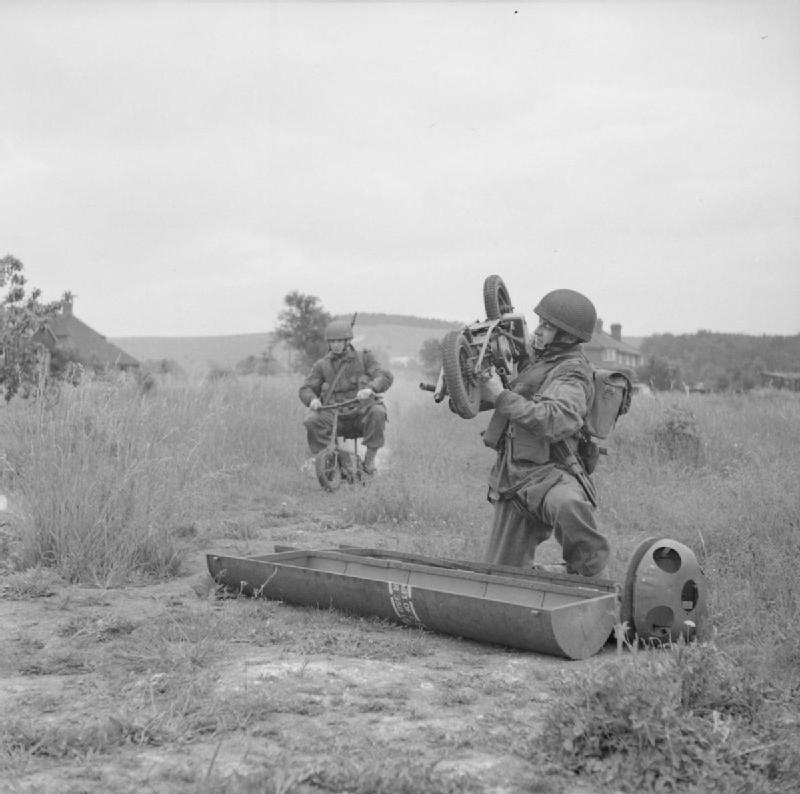
A paratrooper unloads a Welbike from its container, while another paratrooper rides past. (IWM H30628)
The Transport Officer was also required to arrange for two jeeps and trailers to be parked on a road near to the debussing point by 0600 hrs on 16 March, from where a Battalion HQ guide would collect them. Welbikes on a scale of one per Company (two for HQ Company) would also be taken on the exercise. These tiny bikes could be folded into a standard parachute container and were powered by a 98cc engine. This was insufficient power for cross-country work, so it had to be ridden carefully on paths and tracks, avoiding potholes and other obstacles because of its small wheels.
The 2nd Battalion’s Operational Order No 1 gave the Battalion’s objective as the area between the road junction and road bend to the north of the village of Haceby.
The plan was that the Battalion’s assault on the objective would be accomplished in two phases: Phase I would be the move from the RVs to the objective; Phase II would be the action on the objective itself.
For Phase I, the Battalion would be split into two groups, ‘A’ Group and ‘S’ Group. ‘A’ Group would depart the RV at 0230 hrs in the following order: B Company - Battalion HQ - Royal Engineers’ Troop - C Company.
‘S’ Group would depart at 0245 hrs in the following order: S Company - Field Ambulance Detachment - A Company.
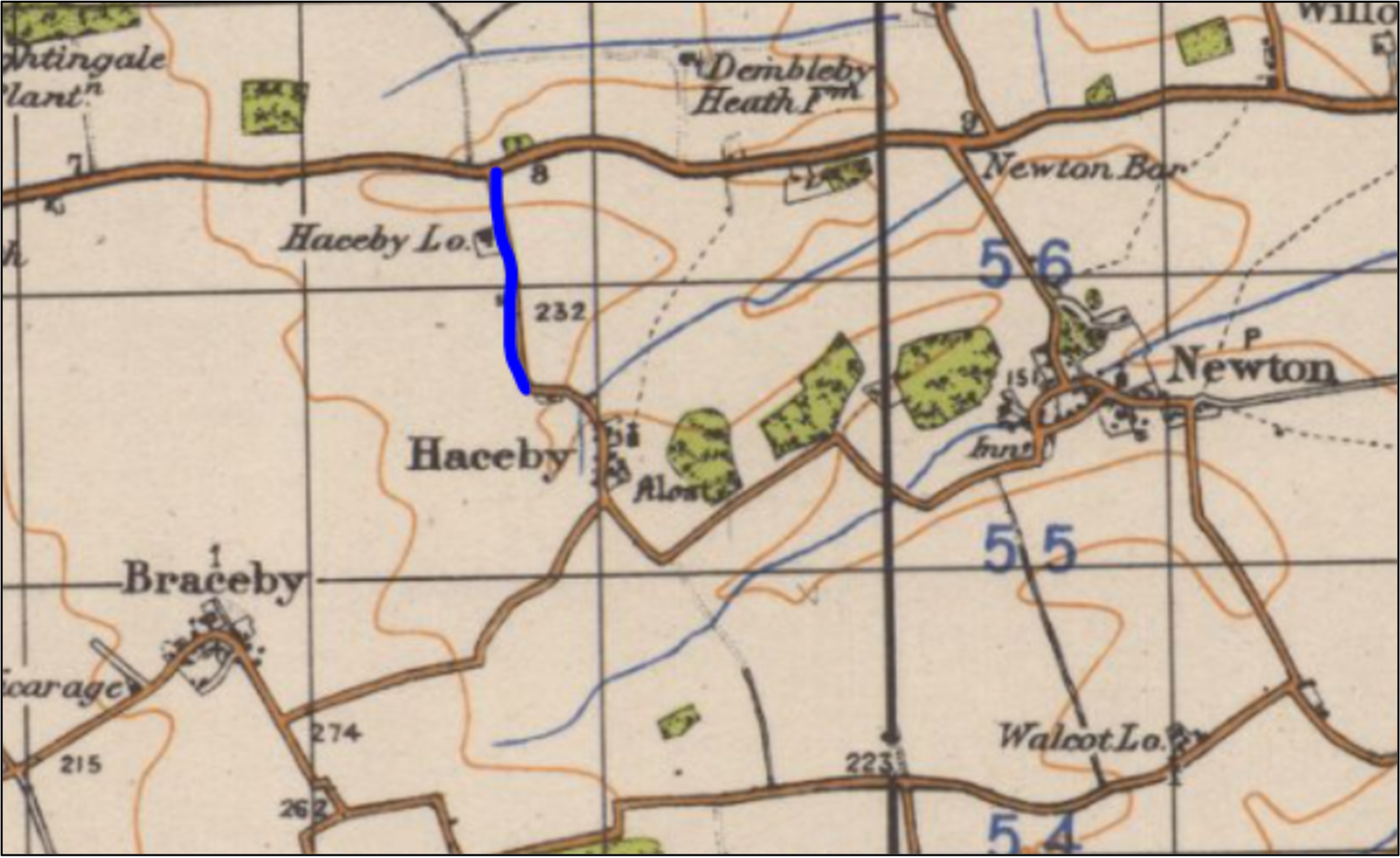
2nd Para Bn was to seize and hold a position north of Haceby, in the area indicated by the blue line.
For Phase II, all units of the Battalion would take up positions of all-round defence and would make ready to counter-attack the positions held by the 1st and 3rd Battalions if the situation demanded it. ‘A’ Company would be responsible at all times for the approach from the west and B Company for the approach from the south (each Company in the Battalion had around 120 men).
Battle Patrols were to be established at first light: B Company to the east of Braceby, and C Company south of Nightingale Plantation. Roadblocks were to be prepared and Battle Patrols would be established by B and C Companies on side roads leading into the Battalion’s positions. Their task was to delay enemy contact with the Battalion’s main positions and to force the enemy to deploy. B Company would patrol east of Braceby and C Company south of Nightingale Plantation. Roadblocks were to be set up and C Company was to establish an Observation Post (OP) to the east of Aisby.

The patrol areas of B Company and C Company, and the location of the C Company OP.
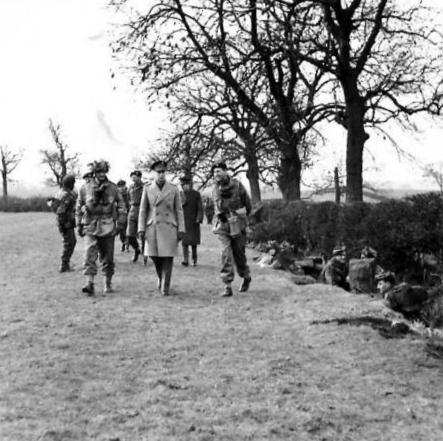
King George VI watches Airborne troops taking cover during Exercise WILLIAM, in the area of the Grantham to Donington Road (now the A52), between Dembleby and Newton, 16 March 1944. NOTE: These could be men of either the 1st or 3rd Parachute Battalions, as the 2nd Battalion was lined up on the road. (IWM H36718)
The Battalion’s War Diary records that the Battalion’s units set off at 0030 hrs on 16 March 1944 along the designated route to the debussing point at Ropsley Heath.
The Battalion reached the debussing point at 0155 hrs, established communications with Brigade Headquarters and set off for its objective at 0230hrs. The objective was captured at 0400 hrs and the Battalion dug in around it.
At 0540 hrs, the Battalion was ‘stood to’, i.e. all troops took up alert defensive positions. It is normal practice for troops to ‘stand to’ before dawn and at dusk because these are the times of the day when attacks are most likely. Well-concealed defenders in static positions are normally difficult to see and they have an advantage over attacking forces. However, the half-light around dawn and dusk reduces this advantage because the human eye has difficulty adjusting to the changing conditions, and it is particularly difficult for it to distinguish movement. Enemy troops can more easily manoeuvre into attacking positions without being spotted by the defenders. A stand-to is normally in force until the lighting condition has stabilized, i.e. it is fully daylight or fully dark, and the human eye has become adjusted to it. The stand-to was in force until 0640 hrs, when the troops were ordered to stand down and individual sentries would provide warning of enemy movements.
At sometime early in morning, the enemy attacked the Battalion’s positions because the War Diary notes at 0945 hrs that A and C Companies captured the positions that had been attacked by the enemy.
At 1015 hrs, an ‘armistice’ was declared because of the visit by HM King George VI. At 1130 hrs, the Battalion lined the west-east road (now the A52) north of Haceby village, and the King arrived at 1140 hrs. After his visit was completed, ‘hostilities’ resumed from 1300 hrs.
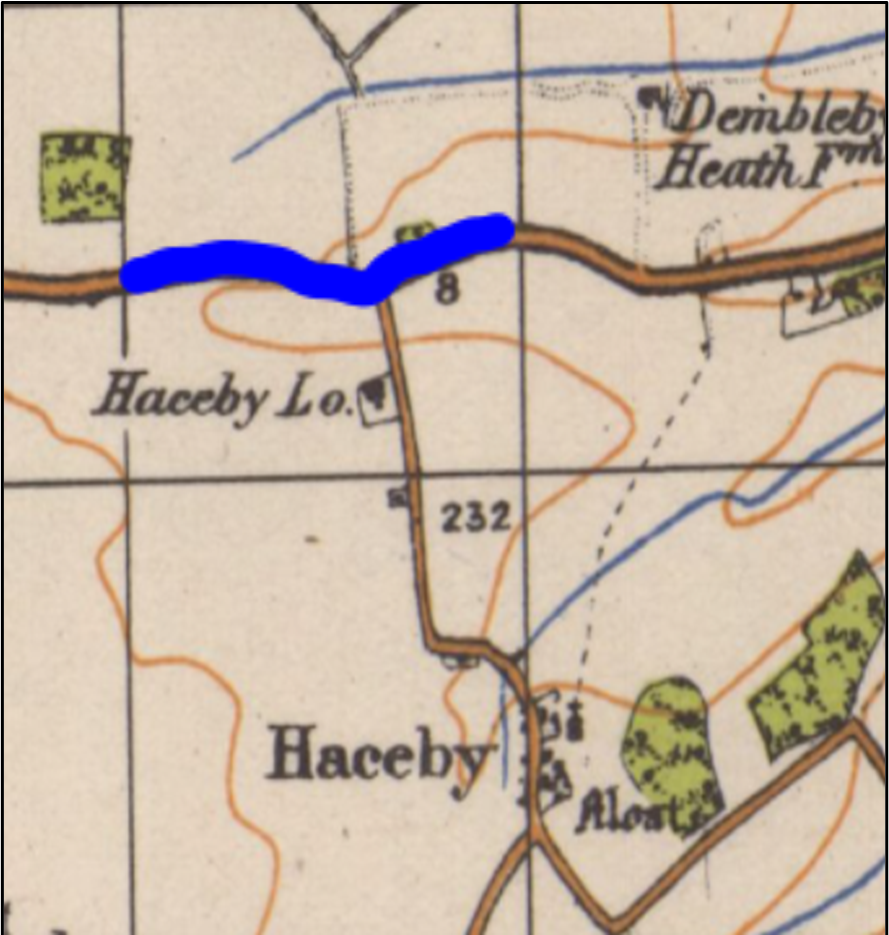
The blue line represents the section of the road lined by the 2nd Parachute Battalion for the King’s visit.
As mentioned previously (see 1st Parachute Battalion above), an entry in the 2nd Battalion’s War Diary at 1630 hrs states that the 2nd Battalion was preparing to counterattack positions of the 1st Battalion that had been overrun by the enemy. At 1930 hrs, the 2nd Battalion’s counterattack commenced, and the 1st Battalion’s positions were recaptured by 2015 hrs. This was the final major event for the 2nd Battalion and the exercise ended at 2100 hrs. The Battalion set off in vehicles back to camp at 2130 hrs, arriving at 2230 hrs, when a hot meal was served.
The War Diary notes that:
Communications throughout the whole of the exercise were very good. Exercise went as planned.
It is ironic that the high quality of communications in Exercise WILLIAM merited special mention in the Battalion’s War Diary. At Arnhem six months later, the British 1st Airborne Division would experience severe difficulties with its communications, and the operation would certainly not go as planned.
3rd Parachute Battalion6
The exercise is mentioned very briefly in the War Diary of the 3rd Parachute Battalion:
15th) Exercise WILLIAM – area DEMBLEBY – (1” sheet 55 – 5056)
16th) Visit to the Battalion of His Majesty The King whilst on Exercise
No comments are recorded in the 3rd Battalion’s War Dairy about the planning or execution phases of the exercise, nor any lessons identified or observations for future improvements.
- 6
National Archives, WO 171/1238.
Acknowledgements
Richard Chancellor, Aviation historian and USAAF research specialist.
Mark Hickman, Creator of the website, The Pegasus Archive, British Airborne Forces 1940-1945. Website: https://www.pegasusarchive.org/
Colonel Mark Vlahos, USAF Retired, Historian and author of Men Will Come, A History of the 314th Troop Carrier Group, 1942-1945. Website: https://markcvlahos.com/
